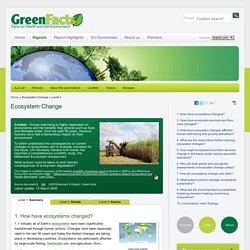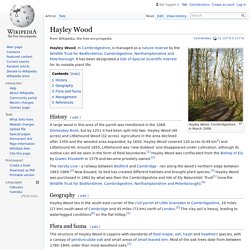

Scene Viewer. Global Ecosystem Explorer. Explore a Tapestry of World Ecosystems. The United States Geological Survey has published a new global ecosystems map of unprecedented detail.

The map was produced by a team led by Roger Sayre, Ph.D., Senior Scientist for Ecosystems at the USGS Land Change Science Program. It is a mosaic of almost 4,000 unique ecological areas called Ecological Land Units (ELUs) based on four factors that are key in determining the makeup of ecosystems. Three of these—bioclimate, landforms, and rock type—are physical phenomena that drive the formation of soils and the distribution of vegetation. The fourth, land cover, is the vegetation that is found in a location as a response to the physical factors. You can read more about the research in this blog post. This Story Map Journal has two main features, an ecosystems browser and an ecosystem tour. In the ecosystem browser, opposite, point and click at any location on the map and the name of that ecosystem appears in a pop-up box. Tropical Rainforest Adaptations. Virtual Field Trip - Amazon Rainforest. World Biomes - Map. The World's Biomes.
GCSE Bitesize: Where are the world’s major biomes? Ecosystems Song. Interdependence in Ecosystems. Scientific Facts on Ecosystem Change. Home » Ecosystem Change » Level 1 Context - Human well-being is highly dependent on ecosystems and the benefits they provide such as food and drinkable water.

Over the past 50 years, however, humans have had a tremendous impact on their environment. To better understand the consequences of current changes to ecosystems and to evaluate scenarios for the future, UN Secretary General Kofi Annan has launched a comprehensive scientific study, the Millennium Ecosystem Assessment. What actions could be taken to limit harmful consequences of ecosystem degradation? Latest update: 15 March 2005 1. 1.1 Virtually all of Earth’s ecosystems have been significantly transformed through human actions. 1.2 Ecosystems depend on fundamental environmental cycles such as the continuous circulation of water, carbon, and other nutrients. 1.3 Many animal and plant populations have declined in numbers, geographical spread, or both. 2. 2.2 uman use of all ecosystem services is increasing: More... 3. 4. 5. 6. 7. 8. 9.
Future - How reintroducing wolves helped save a famous park. Wolves were once the top predator in America’s world-famous Yellowstone National Park.

But the population was eradicated in the 1920s, leaving the wilderness wolf-free for seven decades. In 1995, however, wolves were reintroduced to Yellowstone; this gave biologists a unique opportunity to study what happens when a top predator returns to an ecosystem. They were brought in to manage the rising elk population, which had been overgrazing much of the park, but their effect went far beyond that.
In this film, The Nature Conservancy’s lead scientist Dr M Sanjayan, Dr Valerie Kapos of the UN Environment Programme and animal behaviourist Kirsty Peake describe how the returning wolves dramatically changed the park’s rivers, forests – and the landscape itself. Has The Reintroduction Of Wolves Really Saved Yellowstone? <img class="full-width" style="" typeof="foaf:Image" width="1000" height="692" alt="" data-smsrc="<a pearltreesdevid="PTD497" rel="nofollow" href=" class="vglnk"><span pearltreesdevid="PTD498">http</span><span pearltreesdevid="PTD500">://</span><span pearltreesdevid="PTD502">www</span><span pearltreesdevid="PTD504">.

</span><span pearltreesdevid="PTD506">popsci</span><span pearltreesdevid="PTD508">. </span><span pearltreesdevid="PTD510">com</span><span pearltreesdevid="PTD512">/</span><span pearltreesdevid="PTD514">sites</span><span pearltreesdevid="PTD516">/</span><span pearltreesdevid="PTD518">popsci</span><span pearltreesdevid="PTD520">.
Enlarge U.S. Fish & Wildlife Service A gray wolf watches biologists in Yellowstone National Park, shortly after they fitted it with a tracking collar. The story goes something like this: Once upon a time, we exterminated the wolves from the Rocky Mountain West, including the part that would become Yellowstone National Park. Wolf Reintroduction Changes Ecosystem. On a quiet spring morning, a resounding “Slap!”

Reverberates through the air above a remote stream leading to Lake Yellowstone. Over much of the past century, it has been a rarely heard noise in the soundscape that is Yellowstone National Park, but today is growing more common-the sound of a beaver slapping its tail on the water as a warning to other beavers. When the grey wolf was reintroduced into the Greater Yellowstone Ecosystem in 1995, there was only one beaver colony in the park, said Doug Smith, a wildlife biologist in charge of the Yellowstone Wolf Project. Today, the park is home to nine beaver colonies, with the promise of more to come, as the reintroduction of wolves continues to astonish biologists with a ripple of direct and indirect consequences throughout the ecosystem. A flourishing beaver population is just one of those consequences, said Smith. Hayley Wood. Hayley Wood, Cambridgeshire, in March 2008 Hayley Wood, in Cambridgeshire, is managed as a nature reserve by the Wildlife Trust for Bedfordshire, Cambridgeshire, Northamptonshire and Peterborough.

It has been designated a Site of Special Scientific Interest for its notable plant life. History[edit] A large wood in this area of the parish was mentioned in the 1068 Domesday Book, but by 1251 it had been split into two: Hayley Wood (40 acres) and Littlehound Wood (32 acres). Agriculture in the area declined after 1350 and the wooded area expanded; by 1650, Hayley Wood covered 120 acres (0.49 km2) and Littlehound 40. Geography[edit] Hayley Wood lies in the south-east corner of the civil parish of Little Gransden in Cambridgeshire, 10 miles (17 km) south-west of Cambridge and 45 miles (73 km) north of London.[5] The clay soil is heavy, leading to waterlogged conditions[6] on the flat hilltop.[2] Flora and fauna[edit] Management[edit] The rides and glades are mown to keep nutrient levels down.
Hayley Wood Information Leaflet. Tree felling in hayley wood. Wildlife Trust for Bedfordshire, Cambridgeshire and Northamptonshire. Vince Lea Trees have been removed from the coppice plots in Hayley Wood this winter in order to let more light into the woodland floor.

For more information click here An ancient coppiced woodland with a fantastic display of oxlips in the spring This ancient woodland is a treasure trove of spring flowers and archaeological clues to times past. It is still managed in a traditional way to this day. As you walk up Hayley Lane to approach the wood, the hedge on your left is at least 800 years old and in the winter groans with berries that sustain fieldfares and redwings.